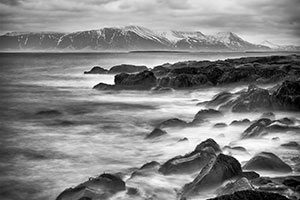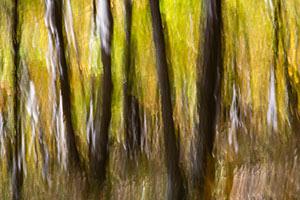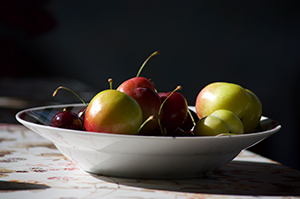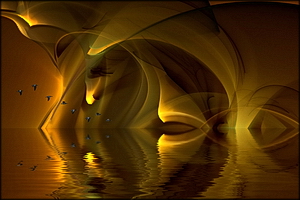
Gallery Partners
Artists-in-Residence
If you are unable to visit our gallery and would like to purchase photographs from this preview or others in the gallery, please contact the gallery and call 585-271-2540.
Partners' Picks of the Show
Holiday Show 2015December 1 to December 23, 2015
Gallery Partners have chosen their "Picks of the Show"
with a commentary on their choices.
click here to return to the details of the exhibit
All images copyright by the individual photographers
Lavaland 2
This is a well-composed image with the background ironically
foreshadowing what may be the accumulated effect of the encroaching
molten lava on the sea. Ryan Beattie is an avid outdoorsman and uses
this exhibit to share his distinctive landscapes.
Lavaland 2 is particularly
remarkable because it shares the qualities of being both harsh and soft
at the same time. The diagonal fingers of the lava jut out into the sea,
creating differing layers of texture, each a reverse image of the
mountain range in the background. The sea with its continual surge is
typically the abrasive agent of rock and beach, yet here is a frothing
cauldron angry at the intrusion of the hot molten lava. In fact, the
rock may or may not be hot at this point, but it doesn’t matter.
Employing his technical expertise, Ryan utilizes a long exposure to
create an undulating ocean with imagined steam where the spray would
appear with a shorter exposure setting.
In this expertly controlled image, Ryan takes us back to the formation
of land caused by molten lava rising from within the earth. It is also a
forward looking image to a constantly evolving landscape.
Bare Hill Trees #18
Steve offers us a new look at traditional
landscapes. This set of images of trees from Bare Hill is a cohesive
collection that accomplishes exactly what Steve was attempting to do;
remove detail of a familiar subject so that only lines, shape, color,
and balance become the most important elements. Steve goes further
stating that he wanted to “…capture the feelings and emotions I
experienced while thoroughly enjoying the beauty of the trees.” Since
photography is a visual art, the other part of the equation is whether
the images produce a similar emotional response from those that view the
image. Bare Hill Trees #18
does that for me. I was not in the woods with Steve when he made this
image, but I honestly get an emotional response looking at this
particular image. It’s as if the abstract interpretation created by
Steve’s photographic method allows me to be part of the forest rather
than be someone looking at the forest. Quite ingenious and a very
successful approach. Congratulations on a wonderful set of images.
Luminous Decay 2
by Kamil Kozan
Photographers sometimes talk about going beyond just “looking” to a
higher level of actually “seeing” when pursuing interesting subject
matter to photograph. Kamil Kozan accomplishes this upward transition to
“seeing” in his photographing of flowing water over colorful leaves. In
so doing, Kamil has creatively produced a wonderful portfolio of
impressionistic abstract photographs.
While most photographers bracket their exposures, Kamil’s subject matter
of flowing water over leaves requires him to also bracket shutter speeds
and to even bracket depth of field. The contrasting of sharp, semi soft,
and very soft focused portions of images is vital in producing these
kinds of high quality abstracts. While several of Kamil’s photographs
are worthy of an Image City Gallery Pick, we have selected his
Luminous Decay – 2 to receive this award. In this image there is an
aesthetic balance of three colors; white, gold, and orange. The use of
the vertical format contributes impact for the three colors and the
areas of sharpness and softness within the image blend particularly
well. The beauty of naturally flowing water over colorful leaves is
artfully communicated in all of Kamil’s images.
Phaseolus coccineus (Scarlet Runner Bean)
One of the components of an excellent photograph is often something
termed "gesture". Most of the time this is applied to photographs of
people; however inanimate things can also show gesture. Obviously
inanimate objects need to show gesture in a different way. Susan's photographs of desiccated parts of plants,
using a wonderful series of macro photography techniques, display this
concept of gesture in an excellent way.
Scarlet Runner Bean lets the
eye move along with the curls in the beans leaf forming a closed loop.
To say more about Susan's technique, she uses her macro photography
skills in a way that produces images that show the object in total focus
from the front to the back, not an easy task! Setting these photographs
against a black background allows the observer to focus solely on the
subject of the photograph, the fascinating shapes and the wide variety
of tones that are displayed.
Scarlet Runner Bean
as well as the rest of the photos in this portfolio go way beyond simply
taking a "grab" photograph of something that looks interesting. The
photographs are beautifully lit, displaying the beautiful textures of
the objects along with the strong compositional skills of the
photographer.
"apricots, cherries and plums for Utrecht"
Adam’s photos are
a montage of a trip to Turkey that he took with his family in part to
visit his wife’s relatives.
apricots, cherries and plums for Utrecht is a distinctly different
photo from the others; a photo of a still life that might well have been
painted by one of the Dutch masters. Taken in late morning or early
afternoon the natural light casts sharp shadows and boldly emphasizes
the highly reflective fruit. Adam skillfully manages the bright light
reflecting off the white bowl and tablecloth and the skin of the fruit
to create a pleasing and realistic photo in such a fashion that one can
almost taste the fruit.
Adam deliberately
portrays the fruit with side lighting that assists our eye to view the
depth of the photo even though it is in two dimensions. The sharp black
background further defines the roundness of the fruit and again helps in
giving depth to the image. Adam also places the fruit so the light is to
the left, so as our eyes “read” the photo from left to right, which is
our usual way that we view the world.
Unable to
communicate in Turkish, Adam used his many photographs while in Turkey
to communicate with the people and show his understanding of their
culture. Thankfully, he is also communicating with us about what he
learned while in Turkey with his family. It is striking that Adam chose
this picture to include in his exhibition. The other photos are clearly
from a different region of the world from ours here in Rochester; the
people dress differently, the urban scenes look distinctive and the
landscape is diverse. Yet the bowl of fruit could be from anywhere. Adam
gives us a clue in his bio when he describes the Turkish people as
having an innate ability to exploit opportunities. One is reminded that
Turkey sits at the nexus of trade routes between Europe and Asia and
still serves as the transit point for trade in that part of the world.
In fact the fruit that Adam depicts may have been similar to the fruit
that was transported over this crossroad during the Renaissance and was
utilized by the Dutch masters in or near Utrecht.
Aurora Canyon
Scott Matyjaszek has created an absolutely stunning image by skillfully
combining two imaging processes. One of these is a photographic image of
geese flying over what appears to be a calm body of water. The
reflection of these flying birds might be part of the original
photographic capture or it may have been created by duplicating and then
adding an inversion of the original image. The direction of movement of
the birds from the left edge of the image towards the center of the
picture leads the viewer into the overall image. The arrow like
formation of flying and reflected geese further directs this movement. The second and more dominating portion of this
image is the magical formation that becomes the environment into which
the birds are flying. Scott created this mystical Disney-like scene
digitally. The exquisite lighting in the scene using bright gold and
different shades of warm colors adds to the beauty and alluring quality
of the overall scene. The circular patterns of structures within the
image produce interesting focal points for the viewer. Scott’s title of
Aurora Canyon is very
appropriate as it describes the feeling of a luminous atmosphere his
image so beautifully communicates.
Gallery Partners' Picks

by Ryan Beattie

by Steve Copeland

by Susan C. Larkin

by Adam Lenio

by Scott
Matyjaszek
Image City Photography Gallery ♦ 722 University Avenue ♦ Rochester, NY 14607 ♦ 585.271.2540
In the heart of ARTWalk in the Neighborhood of the Arts